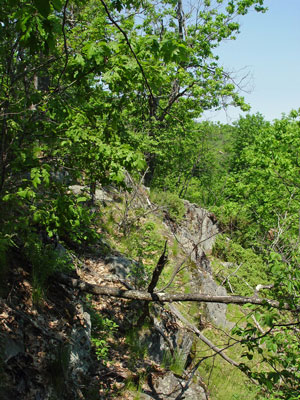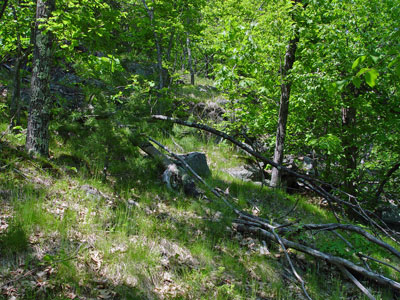DACF Home → Bureaus & Programs → Maine Natural Areas Program → Communities, Plants, and Animals → Natural Community Fact Sheets → Oak - Ash Woodland
Printer Friendly Fact Sheet - 1.1 MB pdf (Get a free copy of Adobe Acrobat Reader)
Oak - Ash Woodland
Scientific Name: Ironwood - Oak - Ash Woodland; State Rank: S3
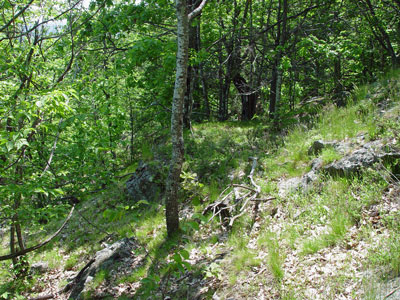
- Community Description
- Soil and Site Characteristics
- Diagnostics
- Similar Types
- Conservation, Wildlife and Management Considerations
- Distribution
- Characteristic Plants
- Associated Rare Plants
- Associated Rare Animals
- Examples on Conservation Lands You Can Visit
Community Description: These partial canopy deciduous woodlands are dominated by red oak and ironwood (the latter often as subcanopy). Basswood is an indicator species. Sugar maple may be codominant at some sites. The herb layer features species typical of somewhat enriched sites, such as Venus’ looking-glass, herb Robert, round-lobed hepatica, plantain-leaved pussytoes, and wild-licorice, among an often dense cover of graminoids. Marginal wood-fern is characteristic of the herb layer. Vegetation may be patchy, developing in pockets among the rocks, or more continuous along upper slopes and ridges. Back to top.
Soil and Site Characteristics: Sites occur on upper hill slopes and ridges or on talus slopes, often with some southerly exposure. Soils are thin and very well drained. The exposure and thin soils create dry conditions. These woodlands usually develop over bedrock that is not strongly acidic. Back to top.
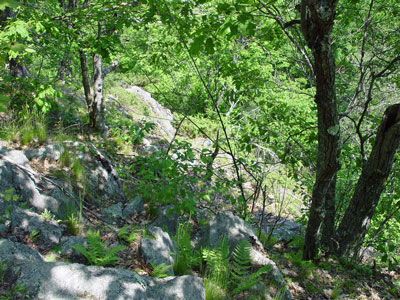
Diagnostics: Ironwood is well represented and may be codominant with red oak. Sugar maple and/or basswood are present if not abundant. Some rich site indicators are present in herb layer. Back to top.
Similar Types: Birch - Oak Rocky Woodlands are similar but have far less ironwood, ash, and sugar maple, generally lack basswood, and have less extensive graminoid cover. Intermediates can be difficult to classify. Enriched Northern Hardwoods Forests share some rich woods species but typically contain less oak and ironwood and occur on deeper, more mesic soils. Back to top.
Conservation, Wildlife and Management Considerations: These types are subject to fragmentation from development pressure in southern Maine. The hilltop setting of many makes them attractive as house sites, although the shallow soils generally will not support intensive residential use. Some sites were probably pastured at some time in the 1700s - 1800s but have regrown. Almost all known sites are on private land with individual ownership.
Sites that have Eastern red cedar present may host the rare juniper hairstreak butterfly, which uses cedar as its larval host plant. Two other insects, the columbine dusky wing butterfly and the aureolaria seed borer moth, may have historically inhabited this community type where they used uncommon larval host plants, columbine and false foxglove, respectively. Back to top.
Distribution: Eastern Broadleaf Forest Province, extending southwestward from Maine. Landscape Pattern: Small Patch. Back to top.
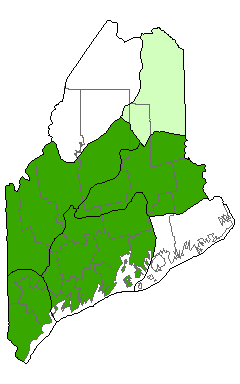

Characteristic Plants: These plants are frequently found in this community type. Those with an asterisk are often diagnostic of this community.
- Canopy
- White Ash
- Ironwood*
- Red oak
- Sugar maple
- Basswood*
- Sapling/shrub
- Beaked hazelnut
- Ironwood*
- Herb
- Columbine
- False spikenard
- Fibrous-rooted sedge
- Marginal woodfern
- Rough-leaved ricegrass
- Round-lobed hepatica
- Woodland sedge*
- Bryoid
- Dicranum moss
- Large hair-cap moss
- Pincushion moss
- Blunt-lobed woodsia
- Bottlebrush grass
- Douglas' knotweed
- Dry land sedge
- Early crowfoot
- Ebony spleenwort
- Fern-leaved false foxglove
- Hairy wood brome-grass
- Missouri rockcress
- Summer grape
- Juniper hairstreak
Examples on Conservation Lands You Can Visit
| Example | County |
|---|---|
| Derry Mountain, Camden Hills State Park | Knox Co. |
